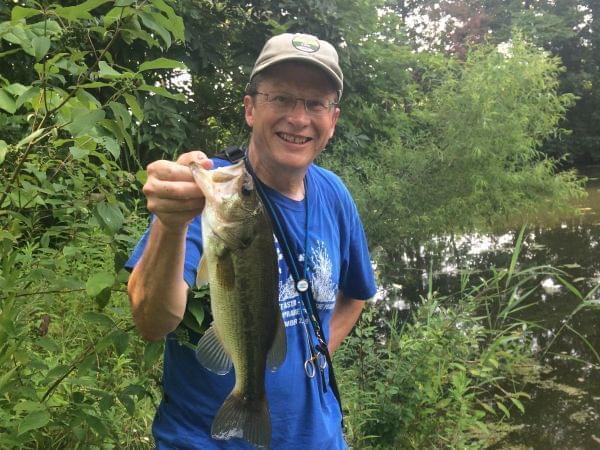A tale of two ponds, plus an invitation to speak on behalf of clean water

A largemouth bass that was caught and released. Susan McIntyre
I had occasion to be around two ponds last Saturday. The first is on a friend’s property in Vermilion County, south of Oakwood. It’s deep and cool and clear, surrounded by woods except the edge formed by the dam. Wooden docks provide access to the water for people who have cabins there and it’s a pond people do access, especially for fishing but also to swim.
From that pond we caught largemouth bass one after another and we kept some of the smaller ones for lunch, on the understanding that fewer fish in the population will enable the remaining ones to grow bigger—and what a lunch we had. You really couldn’t ask for more from a pond.
Later the same day, I was walking another friend’s dog for her in a part of southwest Champaign I’m not familiar with, and we found ourselves on a paved path around a pond ringed by houses. This pond is roughly the size of the one I had fished in the morning, but thoroughly different in character. It’s surrounded by manicured lawn that gives way to a bed of uniform, rounded stones at the edge of the water, so no part of it enjoys the benefit of shade from trees or emergent aquatic vegetation. But what really struck me was the presence of little two by six-foot docks—one per house, many with kayaks on or near them.
Why, I wondered?
This pond is so dominated by bright green algae that it’s difficult to imagine anyone would want to fish there, at least at this time of year, and more difficult still to imagine eating fish caught from it. Likewise, swimming seems out of the question whether or not rules allow it.
Such ponds are dominated by algae because fertilizer intended for the surrounding lawns is carried into the water. It would be possible for interested owners of the surrounding property to improve the quality of that water by choosing collectively to stop putting so much fertilizer on their lawns. But there’s no regulatory framework for governing stuff that comes off of lawns, which is called nonpoint source pollution in discourse about water quality.
Fortunately, when it comes to pollution that comes out of a pipe—point source pollution—there is a regulatory framework established by the federal Clean Water Act. It empowers Illinois EPA to uphold the public’s interest in fishable, swimmable streams and lakes. It’s called the National Pollutant Discharge Elimination System (NPDES).
Weird as it may seem to you if you don’t go around thinking about this stuff, I’ve had the NPDES on my mind lately. That’s because there’s a hearing coming up soon on a draft of an NPDES permit to pollute the Salt Fork River, a river I prize for the paddling and fishing opportunities it offers. The permit is being sought by the company that proposes to open a coal mine southeast of Homer to cover discharges of water associated with the mine.
How can public input matter in this process? It can help ensure the mine site is characterized accurately, especially when people who know the local land and waters are involved. It can also help achieve stricter limits on pollution from the site, as well as better monitoring. The hearing for public comment on the permit will be conducted Wednesday, August 12, beginning at 5:30 pm at the Salt Fork Junior High School in Sidell. Further details about the hearing and how to submit written commentary on the proposed permit are available through the website of the group Stand Up to Coal at standuptocoal.org.

